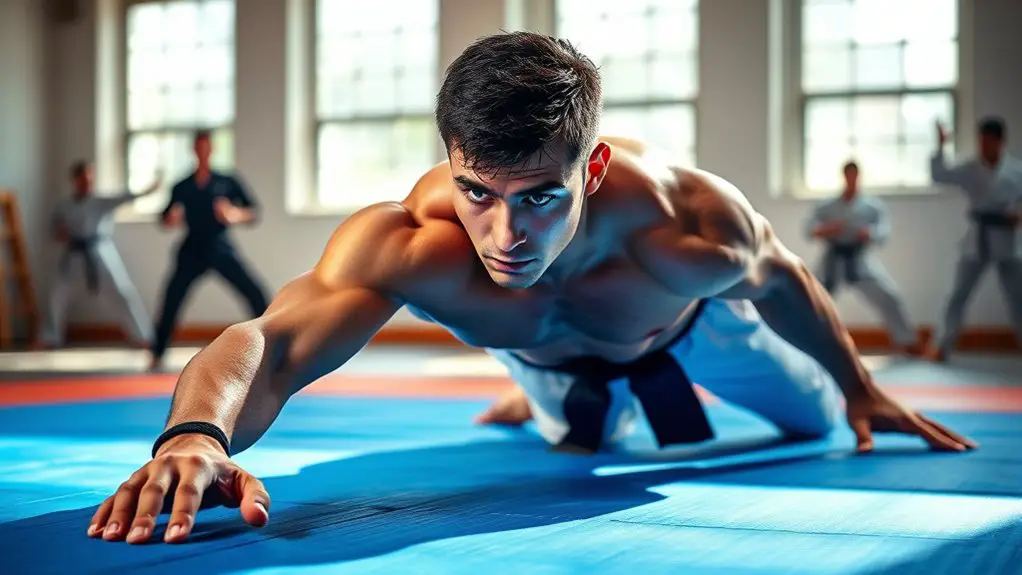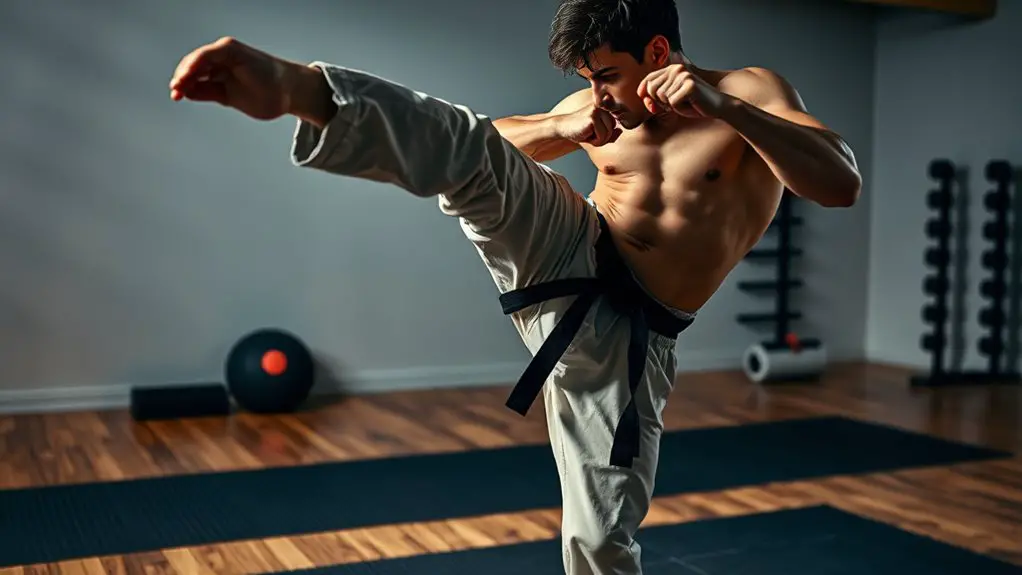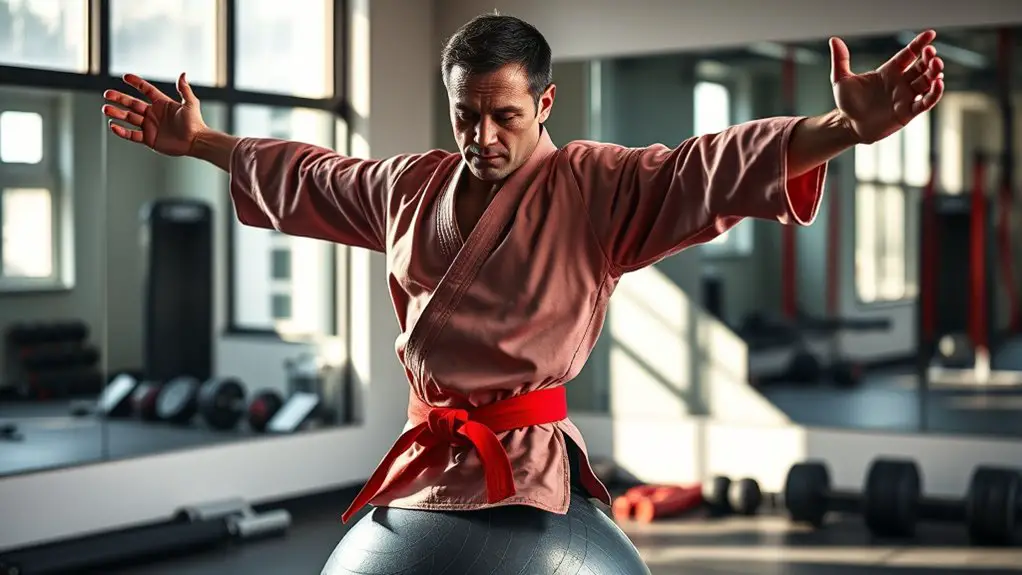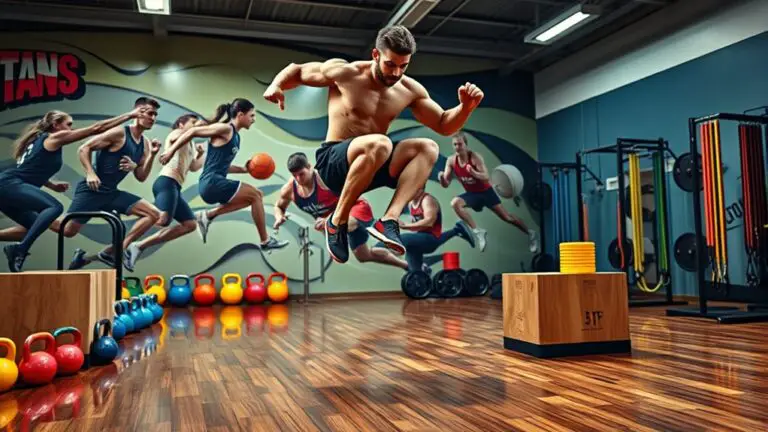How to Train Core Strength for Martial Arts Performance

To enhance your martial arts performance, focus on building core strength by incorporating exercises like planks, Russian twists, and medicine ball throws. These movements engage essential muscles such as your obliques and lower back, improving stability, balance, and power in your techniques. Stick to a consistent schedule of 2-3 times a week while keeping proper form. Remember to track your progress with SMART goals for motivation. There’s so much more you can learn to elevate your training and skills.
Understanding the Role of Core Strength in Martial Arts

While you might think of strength training as primarily focusing on arms and legs, core strength plays an essential role in martial arts performance. Many people have core strength misconceptions, believing that abs alone define core stability. In reality, effective core muscle engagement involves multiple muscle groups, including your obliques, lower back, and pelvis.
When you train your core, you enhance your balance, stability, and power, which are vital for executing techniques effectively. A strong core supports your movements, enabling you to generate force and maintain control during strikes and grapples.
Incorporating exercises like planks, Russian twists, and medicine ball throws can help you develop a well-rounded core. Remember, it’s not just about aesthetics; a strong core is your foundation in martial arts. Embrace the importance of core strength, and watch your performance soar to new heights!
Key Benefits of a Strong Core for Martial Artists
Having a strong core is essential for martial artists looking to boost their performance. It not only enhances your stability and balance but also improves your power generation, making your strikes more effective. Plus, a solid core helps you develop injury prevention strategies that keep you training safely and efficiently.
Enhanced Stability and Balance
How can a strong core transform your martial arts performance? A well-developed core enhances your stability and balance, allowing you to execute dynamic movements with precision. When you engage in balance drills, you’ll notice improved control over your body, helping you maintain your stance during strikes or grappling. This stability not only boosts your confidence but also reduces your risk of injury. As you train your core, focus on exercises that challenge your balance, such as planks and stability ball workouts. Remember, a strong core serves as the foundation for all your movements, enabling you to adapt quickly in sparring and competitions. Embrace this journey, and watch your martial arts skills soar!
Improved Power Generation
A strong core doesn’t just stabilize your movements; it’s vital for generating power in martial arts. When you engage your core effectively, you boost your power output, translating your strength into impactful strikes. This power starts from your center and flows outward, maximizing the force behind every punch, kick, and throw. Rotational strength plays an important role here; it allows you to pivot and twist with speed and precision, enhancing your overall effectiveness in combat. By focusing on core training, you’re not just building endurance and stability; you’re releasing your ability to deliver powerful techniques. So, invest time in core workouts, and watch how your martial arts performance improves dramatically!
Injury Prevention Strategies
While many martial artists focus on strength and technique, the importance of a strong core for injury prevention can’t be overstated. A well-conditioned core enhances your injury awareness, allowing you to recognize potential issues before they escalate. By integrating effective recovery techniques, you can maintain peak performance and minimize downtime.
| Core Benefits | Injury Awareness | Recovery Techniques |
|---|---|---|
| Stabilizes movements | Helps identify risks | Aids muscle recovery |
| Reduces strain | Improves posture | Enhances flexibility |
| Supports balance | Prevents overuse | Encourages active rest |
Strengthening your core is essential not just for performance, but also for keeping you healthy and injury-free in your martial arts journey.
Essential Core Muscles Used in Martial Arts
Understanding the essential core muscles used in martial arts is vital for enhancing your performance. These key muscle groups provide the stability you need to execute powerful techniques and maintain balance during action. By focusing on core strength, you’ll not only improve your skills but also reduce the risk of injury.
Key Muscle Groups
Core strength is crucial for anyone looking to excel in martial arts, as it provides the foundation for powerful movements and stability. The key muscle groups involved include the rectus abdominis, obliques, and transverse abdominis. Engaging these muscles helps improve core engagement, allowing for better balance and control during techniques. Don’t overlook the importance of your lower back and hip flexors, either; they play significant roles in muscle activation and stability. Strengthening these areas enables you to generate more force in your strikes and shifts. Incorporate exercises like planks, Russian twists, and leg raises into your training regimen. By focusing on these core muscle groups, you’ll enhance your martial arts performance and overall physical conditioning.
Importance of Core Stability
When you prioritize core stability in your martial arts training, you set yourself up for success in both performance and injury prevention. Core stability benefits go beyond just aesthetics; it enhances your balance, power, and agility. Many people fall victim to core strength misconceptions, believing that only visible abs equate to a strong core. In reality, it’s about the deep muscles that stabilize your spine and pelvis. By focusing on exercises that target these essential muscles, you’ll improve your ability to execute techniques with precision and reduce the risk of injury. Incorporating stability training into your routine isn’t just beneficial; it’s essential for any serious martial artist aiming for excellence. Embrace core stability, and watch your performance soar!
Effective Core Strengthening Exercises

Building a strong core is essential for enhancing your martial arts performance, and incorporating effective exercises into your routine can make all the difference. Start by integrating plank variations—like side planks and plank jacks—into your workouts. These not only build stability but also engage your entire core, improving your balance during strikes and movements.
Next, focus on rotational movements such as Russian twists and medicine ball throws. These exercises mimic the twisting actions you’ll use in martial arts, helping increase your power and agility. Remember to keep your movements controlled and maintain proper form to maximize effectiveness and prevent injury.
Consistency is key, so aim to include these core-strengthening exercises at least two to three times a week. With dedication and the right focus, you’ll notice improvements in your technique, speed, and overall performance in martial arts. Keep pushing yourself, and you’ll see the results!
Incorporating Core Training Into Your Martial Arts Routine
Integrating core training into your martial arts routine can elevate your skills and performance. A strong core enhances your stability, power, and overall agility, making it essential for martial artists. Here are three practical tips to incorporate core workouts effectively:
- Schedule Regular Sessions: Aim for core workouts at least 2-3 times a week, allowing your muscles to recover between sessions. Consistent training frequency is key to building strength.
- Combine with Techniques: Include core exercises in your warm-up and cool-down routines. This not only saves time but also allows you to focus on form during your martial arts techniques.
- Use Functional Movements: Choose exercises that mimic martial arts movements, like medicine ball throws or planks with rotation, to enhance your performance on the mat.
Common Mistakes to Avoid When Training Your Core

While core training is essential for enhancing your martial arts performance, many practitioners fall into common pitfalls that can hinder their progress. Here are some common mistakes to avoid:
| Mistake | Description | Solution |
|---|---|---|
| Ignoring Proper Form | Many overlook alignment and posture. | Focus on technique first. |
| Overtraining | Training too much can lead to fatigue. | Schedule rest days. |
| Neglecting Variety | Sticking to the same exercises limits growth. | Mix up your routine. |
| Relying on Isolation | Only doing crunches ignores stabilizing muscles. | Include full-body movements. |
| Misunderstanding Core Function | Core isn’t just abs; it stabilizes the body. | Train all core areas. |
Avoiding these core training misconceptions and common technique errors can greatly boost your martial arts performance. Stay mindful and adjust your approach for ideal results!
Tracking Progress and Setting Goals for Core Strength
Mistakes in core training can set you back, but tracking your progress and setting clear goals can propel you forward. To maximize your core strength, consider these steps for effective goal tracking and progress assessment:
- Set SMART Goals: Make sure your goals are Specific, Measurable, Achievable, Relevant, and Time-bound. For instance, aim to increase your plank duration by 30 seconds within a month.
- Use a Journal: Document your workouts, noting exercises, reps, and how you feel. This will help you identify patterns and areas for improvement.
- Regular Assessments: Schedule monthly check-ins to evaluate your strength. Measure your performance with exercises like sit-ups or leg raises to see tangible progress.
Frequently Asked Questions
How Often Should I Train My Core for Optimal Results?
You should aim for core training frequency of about three to four times a week for ideal results. This allows your muscles to engage and strengthen while also providing optimal recovery time. Mixing up your workouts with different exercises can keep things interesting and effective. Remember, consistency is key, but listen to your body; if you’re feeling fatigued, it’s okay to take a break. Keep pushing yourself, and you’ll see great improvements!
Can I Do Core Exercises Without Gym Equipment?
Absolutely, you can do core exercises without any gym equipment! Bodyweight exercises like planks, leg raises, and mountain climbers are fantastic for building strength. You can also incorporate stability training through moves like bird dogs or single-leg balances. These exercises not only strengthen your core but improve overall stability, which is essential. Remember, consistency is key, so make these exercises a regular part of your routine, and you’ll see great results!
What Is the Best Time of Day to Train My Core?
You might think there’s a perfect time to train your core, but it really depends on your schedule and personal preference. Morning workouts can energize you for the day, while evening routines can help relieve stress after a long day. Listen to your body and choose a time that feels right for you. Consistency is key, so find a routine that fits into your lifestyle, and you’ll see the best results!
How Can I Prevent Core Injuries During Training?
To prevent core injuries during training, focus on developing core stability. Start with exercises that strengthen your core without overexerting yourself. Gradually increase intensity, ensuring you maintain proper form. Incorporate dynamic movements to enhance stability and flexibility. Don’t forget to warm up and cool down; this aids in injury prevention. Listen to your body—if something feels off, take a break. Consistent attention to these practices will keep you strong and safe.
Are There Specific Diets to Support Core Strength Training?
Ever wonder what fuels your core strength training? A well-balanced diet is essential! Focus on lean protein sources like chicken, fish, and legumes to help build and repair muscles. Don’t underestimate hydration’s importance, either; staying well-hydrated aids performance and recovery. Incorporate whole grains, fruits, and veggies for energy and nutrients. By combining these elements, you’ll support your training effectively and reach your goals faster. Keep pushing forward—you’ve got this!





